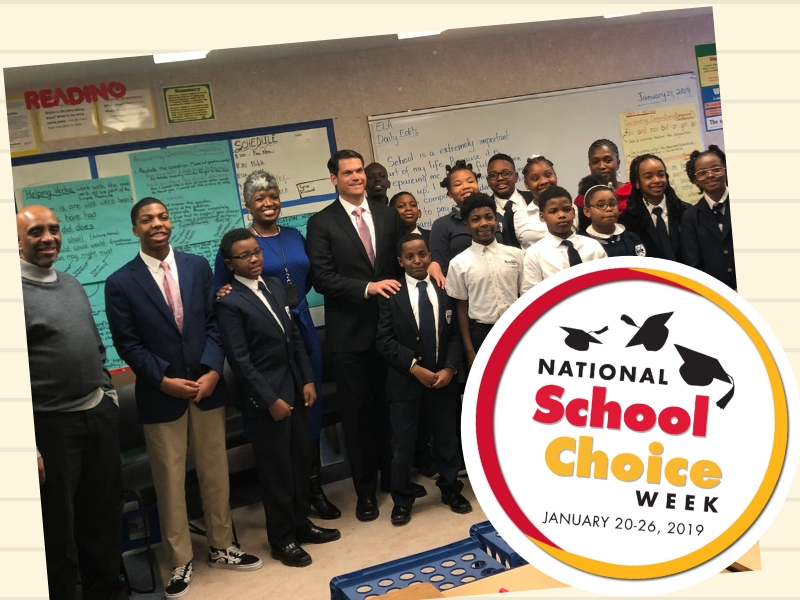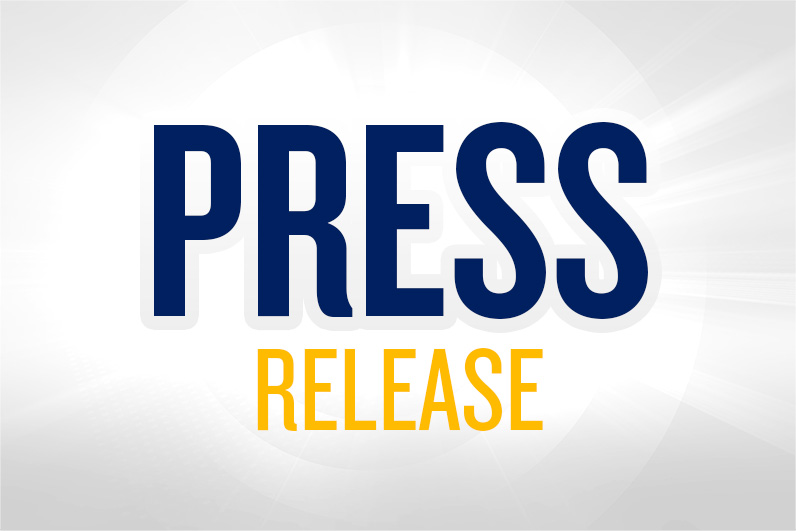
by Georgia Center for Opportunity | Jan 24, 2019
This week marks National School Choice Week, a program that began in 2011 and has rapidly grown across the country highlighting the benefits and need for more school choice options. Lt. Gov. Duncan is leading the state’s celebration at Atlanta Youth Acadamy in Southeast Atlanta by talking with students and parents yesterday about the importance of education, and how remaining focused on expanding school choice opportunities to students statewide is one of his top priorities.
“One of the most important things I can do every day as Lt. Gov. is remember one of the best gifts we can give a child in this state is a quality k-12 education,” stated Lt. Gov. Duncan as he spoke with a classroom of fifth graders and parents. “I want parents to know that and want them to see when we make laws, or adjust things in the laws, and create new policies we realize it is centered around the kids.”
The school is located near the federal prison, and the students’ median household income is about $23,000 a year. Fighting to overcome the neighborhood statistics, 62 percent of the students participate in Georgia’s tax credit scholarship program, and 100 percent of the students have graduated and gone on to postsecondary education.
The tax credit scholarship program has been wildly successful reaching the program’s cap within a matter of days for consecutive years. Lawmakers expanded the program last year by doubling the cap to $100 million starting in 2019.
A quality education is key. It provides a primary path for breaking cycles of poverty. GCO has played a crucial role in bringing real educational choice to upwards of 250,000 students and counting through Tax-Credit Scholarships, Special Needs Scholarships, and charter schools. As we move forward in the legislative session, we will continue to fight to expand Georgia’s current programs and to create education opportunity by pushing for the adoption of Education Scholarship Accounts.
Our work isn’t done until all of Georgia’s children can access the educational options that allow them to achieve the American Dream.

by Georgia Center for Opportunity | Oct 15, 2018
The mandate from Georgia voters is clear—by an overwhelming margin, they want lawmakers in the General Assembly to pass legislation expanding school choice in 2019. That’s the finding of a new poll released by the Georgia Center for Opportunity (GCO).
The survey found that nearly seven-in-ten (67 percent) voters say it’s important for the state legislature to enact policies that expand school choice in the next legislative session, and that support extends across party, racial, and geographic lines. Of all school choice measures available in Georgia, the Tax Credit Scholarship Program garnered the most support.
Underscoring the bipartisan nature of school choice, the survey found strong support for school choice regardless of political affiliation—75 percent of Republicans, 65 percent of Independents, and 62 percent of Democrats. Support is strong across racial and geographic lines as well: 70 percent of African-American voters and 66 percent of white voters support school choice, while voters in Augusta (76 percent), Atlanta (68 percent), and Savannah (65 percent) are also supportive.
These new survey results come on the heels of the General Assembly’s move this year to expand the Tax Credit Scholarship Program to serve tens of thousands of additional students in need of options. In 2019, lawmakers could take up legislation to make Georgia the seventh state to enact Education Savings Accounts, an innovative way for parents to pay for the education their children need.
With the 2019 session of the General Assembly a few months away, elected officials would be wise to pay attention to the voices of more than two-thirds of Georgia’s likely voters—and voice their support for school choice, too!

by Georgia Center for Opportunity | Oct 12, 2018
Peachtree Corners—A new poll released by the Georgia Center for Opportunity (GCO) has found that a significant majority of likely Georgia voters—to the tune of 68 percent—support school choice for families across the state.
Ahead of the 2019 legislative session, nearly seven-in-ten (67 percent) voters say it’s important for the state legislature to enact policies that expand school choice in the next legislative session, and that support extends across party, racial, and geographic lines. Of all school choice measures available in Georgia, the Tax Credit Scholarship Program garnered the most support.
Underscoring the bipartisan nature of school choice, the survey found strong support for school choice regardless of political affiliation—75 percent of Republicans, 65 percent of Independents, and 62 percent of Democrats. Support is strong across racial and geographic lines as well: 70 percent of African-American voters and 66 percent of white voters support school choice, while voters in Augusta (76 percent), Atlanta (68 percent), and Savannah (65 percent) are also supportive.
“School choice has long been, and continues to be, a winning issue,” said Randy Hicks, GCO’s president and CEO. “No matter who’s leading under the Gold Dome in 2019, Georgians recognize its importance for creating a better tomorrow for every child, but particularly those from disadvantaged backgrounds who need help the most.”
The survey was conducted by WPA Intelligence. Interviews were collected from September 19-23 among over 600 likely voters in Georgia. The margin of error was plus or minus 4 percent.
Get more details about the poll here: GCO Poll Memo

by Georgia Center for Opportunity | Sep 24, 2018
A new poll from Education Next shows a surge in support for educational choice programs nationwide. Across the board, support is up for publicly funded school-choice scholarships, tax-credit scholarships, and public charter schools.
And not only is public support for school choice on the rise, it has jumped from plurality to majority support on several key data points:
- Support for publicly funded school-choice scholarships jumped from 45% in 2017 to 54% in 2018. More parents than ever support these scholarships—61%, up from 52% in 2017.
- While 43% support school-choice scholarships for low-income students, 56% of African American and 62% of Hispanic respondents favor them.
- Hispanic families in particular see the benefits of educational choice, with support for publicly funded school-choice scholarships increasing from 49% in 2017 to 67% in 2018.
Other insights:
- Support for public charter schools increased from 39% in 2017 to 44% in 2018.
- Opposition to publicly funded school-choice scholarships has decreased 13 percentage points since 2016, from 44% to 31% today.
While these results are good news for school-choice proponents nationwide, here in Georgia we continue to be a trendsetter in educational opportunity—ranking seventh nationally thanks to a series of school-choice laws passed since 2008, including the Tax Credit Scholarship Program and the Special Needs Scholarship Program.
All told, Georgia’s school choice programs have delivered impressive results—with more than 17,000 students benefitting in the 2016-17 school year, including 13,600 children participating in the tax credit scholarship program and 4,000 receiving tuition assistance through the Special Needs Scholarship Program.
And these programs are popular across key demographics such as political affiliation, age, and race. In Georgia, 84% of Republicans, 67% of Independents, and 55% of Democrats support school choice. Among Millennials and minorities, support is even stronger—and growing—with 74% of Latinos, 72% of African Americans, and 75% of Millennials in favor.
Even though most students will continue to be educated in traditional public schools, it’s nice to see the latest Education Next poll confirm nationally what we already know here in Georgia: School-choice options empower parents to make the best educational decisions for their children and give them the best shot to live a flourishing life.

by Georgia Center for Opportunity | Sep 5, 2018
PEACHTREE CORNERS – On Tuesday, the Georgia Center for Opportunity (GCO) announced that Buzz Brockway, an outgoing state representative from Lawrenceville, has joined the group’s executive leadership team as Vice President of Public Policy.
Since being elected to the legislature in 2010, Brockway has, among other things, sponsored and co-sponsored several bills aimed at increasing economic opportunity for Georgia families, protecting victims of human trafficking, and punishing abusers. As the Vice President of Public Policy, he will coordinate policy research and reform efforts aligned with GCO’s mission to provide all Georgians with access to quality education, meaningful work, and healthy relationships.
“This is a good day for GCO because we’re adding such a great person to our team. But this is also a good day for the people of Georgia, because it ensures that one the state’s most thoughtful and capable leaders continues to invest his considerable talents in the effort to create opportunities for all Georgians,” said Randy Hicks, President and CEO of the Georgia Center for Opportunity.
###



